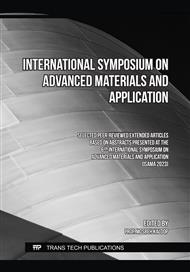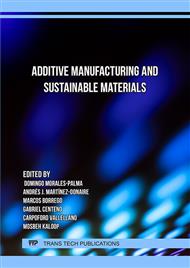[1]
Information on https://www.jeccomposites.com/news/tu-e-leads-project-for-worlds-first-smart- circular-bridge-in-a-city/.
Google Scholar
[2]
Information on https://www.jeccomposites.com/news/fibrous-tectonics-towards-bio-based-and- bio-inspired-architecture/.
Google Scholar
[3]
H. Katogi, K. Uematsu, Y. Shimamura, K. Tohgo, T. Fujii, K. Takemura, Effect of cyclic frequency and time-dependent fracture on fatigue strength of jute monofilament, J. Jpn Soc. Compos. Mater. 41 (2015) 47-54 (in Japanese).
DOI: 10.6089/jscm.41.47
Google Scholar
[4]
H. Katogi, K. Uematsu, Y. Shimamura, K. Tohgo, T. Fujii, K. Takemura, Fatigue property and fatigue damage accumulation of jute monofilament, J. Jpn Soc. Compos. Mater. 41 (2015) 25-32 (in Japanese).
DOI: 10.6089/jscm.41.25
Google Scholar
[5]
R. Scaffaro, M.C. Citarrella, E.F. Gulino, M. Morreale, Hedysarum coronarium-based green composites prepared by compression molding and fused deposition modeling, Mater. 15 (2022) 465.
DOI: 10.3390/ma15020465
Google Scholar
[6]
A.N. Nakagaito, H. Takagi, Y. Katsumoto, Fabrication of strong macrofibers from plant fiber bundles, Int. J. Mod. Phys. B 35 (2021) 2140005.
DOI: 10.1142/s0217979221400051
Google Scholar
[7]
H. Katogi, Y. Shimamura, K. Tohgo, T. Fujii, K. Takemura, Effect of matrix ductility on fatigue strength of unidirectional jute spun yarns impregnated with biodegradable plastics, Adv. Compos. Mater. 27 (2018) 235-247.
DOI: 10.1080/09243046.2017.1381896
Google Scholar
[8]
K. Tanaka, T. Shiga, T. Katayama, Fabrication of hydroxyapatite/PLA composite nanofibers and effects of surface treatment of hydroxyapatite on their mechanical properties and dispersion, J. Soc. Mater. Sci. Jpn. 67 (2018) 291-298 (in Japanese).
DOI: 10.2472/jsms.67.291
Google Scholar
[9]
B. Ren, T. Mizue, K. Goda, J. Noda, Effects of fluctuation of fibre orientation on tensile properties of flax sliver-reinforced green composites. Compos. Struct. 94 (2012) 3457-3464.
DOI: 10.1016/j.compstruct.2012.06.002
Google Scholar
[10]
H. Katogi, K. Takemura, Flexural properties of flax sliver reinforced green composite by molding pressure and chitosan fiber addition, WIT Trans. Eng. Sci. 124 (2019) 93-99.
DOI: 10.2495/mc190091
Google Scholar
[11]
K. Haraguchi, N. Suizu, T. Uno, K. Goda, J. Noda, J. Ohgi, Effect of alkali treatment on the tensile and impact properties of ramie plied yarn-reinforced green composites, J. Soc. Mater. Sci. Jpn. 58 (2009) 374-381 (in Japanese).
DOI: 10.2472/jsms.58.374
Google Scholar
[12]
K. Takemura, S. Takai, H. Katogi, Effects of microfibrillated cellulose addition and water absorption on mechanical properties of jute/PLA composites, WIT Trans. Built Environ. 124 (2012) 387-394.
DOI: 10.2495/hpsm120341
Google Scholar
[13]
O. Platnieks, S. Gaidukovs, A. Barkane, A. Sereda, G. Gaidukova, L. Grase, V.K. Thakur, I. Filipova, V. Fridrihsone, M. Skute, M. Laka, Bio-based poly (butylene succinate)/microcrystalline cellulose/nanofibrillated cellulose-based sustainable polymer composites: Thermo-mechanical and biodegradation studies, Polymers 12 (2020) 1472.
DOI: 10.3390/polym12071472
Google Scholar
[14]
M. Bulota, K. Kreitsmann, M. Hughes, J. Paltakari, Acetylated microfibrillated cellulose as a toughening agent in poly (lactic acid), J. Appl. Polym. Sci. 126 (2012) E449-E458.
DOI: 10.1002/app.36787
Google Scholar



